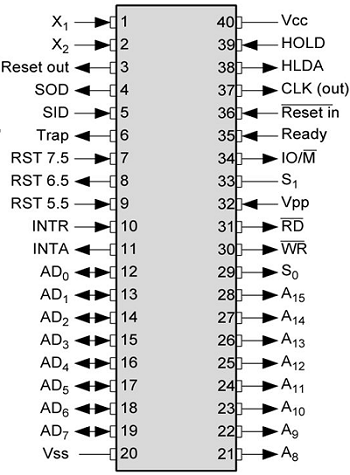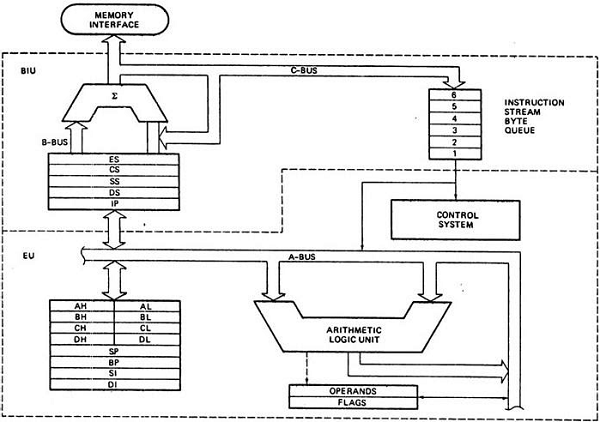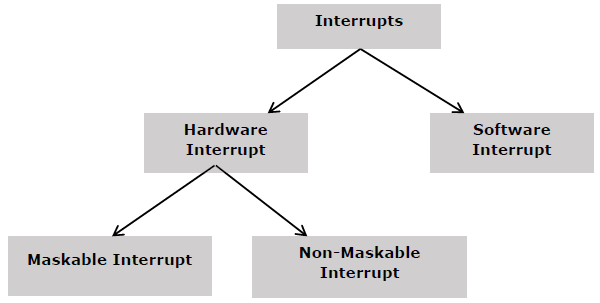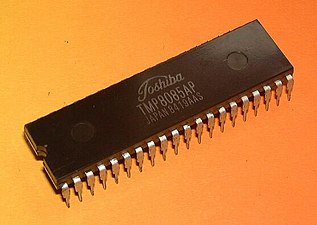| sr.no. | 8085 | 8086 |
|---|---|---|
 | ||
| 1 | The data bus is of 8 bits. | The data bus is of 16 bits. |
| 2 | The address bus is of 16 bits. | The address bus is of 20 bits. |
| 3 | The memory capacity is 64 KB.Also 8085 Can Perform Operation Upto 2^8 ie. 256 numbers. A number greater than this is to taken multiple times in 8 bit data bus. | The memory capacity is 1 MB.Also 8086 Can Perform Operation upto 2^16 ie. 65,536 numbers. |
| 4 | The input/output port addresses are of 8 bits. | The input/output port addresses are of 8 bits. |
| 5 | The operating frequency is 3.2 MHz. | The operating frequency is 5 MHz, 8MHZ,10MHZ. |
| 6 | 8085 MP has Single Mode Of Operation. | 8086 MP has Two Modes Of Operation.1. Minimum Mode = SingLe CPU PROCESSOR2. Maximum Mode = Multiple CPU PROCESSOR. |
| 7 | It not have multiplication and division instructions. | It have multiplication and division instructions. |
| 8 | It does not support pipe-lining. | It supports pipe-lining as it has two independent units Execution Unit (EU) and Bus Interface Unit (BIU). |
| 9 | It does not support instruction queue. | It supports instruction queue. |
| 10 | Memory space is not segmented. | Memory space is segmented. |
| 11 | It consists of 5 flags(Sign Flag, Zero Flag, Auxiliary Carry Flag, Parity Flag, Carry Flag). | It consists of 9 flags(Overflow Flag, Direction Flag, Interrupt Flag, Trap Flag, Sign Flag, Zero Flag, Auxiliary Carry Flag, Parity Flag, Carry Flag). |
8086
Saturday, April 11, 2020
Difference between 8085 and 8086
Applications of 8085
For the extensive use of 8085 in various applications, the microprocessor is provided with an instruction set consisting of various instructions such as MOV, ADD, SUB, JMP, etc. These instructions are written in the form of a program which is used to perform various operations such as branching, addition, subtraction, bitwise logical, and bit shift operations. More complex operations and other arithmetic operations must be implemented in software. For example, multiplication is implemented using a multiplication algorithm.
The 8085 processor was used in a few early personal computers, for example, the TRS-80 Model 100 line used an OKI manufactured 80C85 (MSM80C85ARS). The CMOS version 80C85 of the NMOS/HMOS 8085 processor has several manufacturers. In the Soviet Union, an 80C85 clone was developed under the designation IM1821VM85A (Russian: ИМ1821ВМ85А) which in 2016 was still in production.Some manufacturers provide variants with additional functions such as additional instructions. The rad-hard version of the 8085 has been in on-board instrument data processors for several NASA and ESA space physics missions in the 1990s and early 2000s, including CRRES, Polar, FAST, Cluster, HESSI, the Sojourner Mars Rover,and THEMIS. The Swiss company SAIA used the 8085 and the 8085-2 as the CPUs of their PCA1 line of programmable logic controllers during the 1980s.
Pro-Log Corp. put the 8085 and supporting hardware on an STD Bus format card containing CPU, RAM, sockets for ROM/EPROM, I/O and external bus interfaces. The included Instruction Set Reference Card uses entirely different mnemonics for the Intel 8085 CPU, as the product was a direct competitor to Intel's Multibus card offerings.
- Intel 8085
Real Life Applications of 8086
The availability of low cost, low power and small weight, computing capability makes it useful in different applications. Now a days, a microprocessor based systems are used in instructions, automatic testing product, speed control of motors, traffic light control , light control of furnaces etc. Some of the important areas are mentioned below:
Instrumentation:
Control:
Microprocessor based controllers are available in home appliances, such as microwave oven, washing machine etc., microprocessors are being used in controlling various parameters like speed, pressure, temperature etc. These are used with the help of suitable transduction.
Communication:
Microprocessors are being used in a wide range of communication equipments. In telephone industry, these are used in digital telephone sets. Telephone exchanges and modem etc. The use of microprocessor in television, satellite communication have made teleconferencing possible. Railway reservation and air reservation system also uses this technology. LAN and WAN for communication of vertical information through computer network.
Office Automation and Publication:
Microprocessor based micro computer with software packages has changed the office environment. Microprocessors based systems are being used for word processing, spread sheet operations, storage etc. The microprocessor has revolutionize the publication technology.
Consumer:
The use of microprocessor in toys, entertainment equipment and home applications is making them more entertaining and full of features. The use of microprocessors is more widespread and popular.Now the Microprocessors are used in :
- Calculators
- Accounting system
- Games machine
- Complex Industrial Controllers
- Traffic light Control
- Data acquisition systems
- Multi user, multi-function environments
- Military applications
- Communication systems
8085 Microprocessor
8085 - overview
The Intel 8085 is an 8-bit microprocessor produced by Intel and introduced in March 1976. It is a software-binary compatible with the more-famous Intel 8080 with only two minor instructions added to support its added interrupt and serial input/output features. However, it requires less support circuitry, allowing simpler and less expensive microcomputer systems to be built.
The "5" in the part number highlighted the fact that the 8085 uses a single +5-volt (V) power supply by using depletion-mode transistors, rather than requiring the +5 V, −5 V and +12 V supplies needed by the 8080. This capability matched that of the competing Z80, a popular 8080-derived CPU introduced the year before. These processors could be used in computers running the CP/M operating system.
Features of 8085
8085 is pronounced as "eighty-eighty-five" microprocessor. It is an 8-bit microprocessor designed by Intel in 1977 using NMOS technology.
It has the following configuration −
- 1. 8-bit data bus
- 2. 16-bit address bus, which can address upto 64KB
- 3. A 16-bit program counter
- 4. A 16-bit stack pointer
- 5. Six 8-bit registers arranged in pairs: BC, DE, HL
- 6. Requires +5V supply to operate at 3.2 MHZ single phase clock
It is used in washing machines, microwave ovens, mobile phones, etc.
8085 Microprocessor – Functional Units
8085 consists of the following functional units −
Accumulator
It is an 8-bit register used to perform arithmetic, logical, I/O & LOAD/STORE operations. It is connected to internal data bus & ALU.
Arithmetic and logic unit
As the name suggests, it performs arithmetic and logical operations like Addition, Subtraction, AND, OR, etc. on 8-bit data.
General purpose register
There are 6 general purpose registers in 8085 processor, i.e. B, C, D, E, H & L. Each register can hold 8-bit data.
These registers can work in pair to hold 16-bit data and their pairing combination is like B-C, D-E & H-L.
Program counter
It is a 16-bit register used to store the memory address location of the next instruction to be executed. Microprocessor increments the program whenever an instruction is being executed, so that the program counter points to the memory address of the next instruction that is going to be executed.
Stack pointer
It is also a 16-bit register works like stack, which is always incremented/decremented by 2 during push & pop operations.
Temporary register
It is an 8-bit register, which holds the temporary data of arithmetic and logical operations.
Flag register
It is an 8-bit register having five 1-bit flip-flops, which holds either 0 or 1 depending upon the result stored in the accumulator.
These are the set of 5 flip-flops −
- Sign (S)
- Zero (Z)
- Auxiliary Carry (AC)
- Parity (P)
- Carry (C)
Instruction register and decoder
It is an 8-bit register. When an instruction is fetched from memory then it is stored in the Instruction register. Instruction decoder decodes the information present in the Instruction register.
Timing and control unit
It provides timing and control signal to the microprocessor to perform operations. Following are the timing and control signals, which control external and internal circuits −
- Control Signals: READY, RD’, WR’, ALE
- Status Signals: S0, S1, IO/M’
- DMA Signals: HOLD, HLDA
- RESET Signals: RESET IN, RESET OUT
Interrupt control
As the name suggests it controls the interrupts during a process. When a microprocessor is executing a main program and whenever an interrupt occurs, the microprocessor shifts the control from the main program to process the incoming request. After the request is completed, the control goes back to the main program.
There are 5 interrupt signals in 8085 microprocessor: INTR, RST 7.5, RST 6.5, RST 5.5, TRAP.
Serial Input/output control
It controls the serial data communication by using these two instructions: SID (Serial input data) and SOD (Serial output data).
Address buffer and address-data buffer
The content stored in the stack pointer and program counter is loaded into the address buffer and address-data buffer to communicate with the CPU. The memory and I/O chips are connected to these buses; the CPU can exchange the desired data with the memory and I/O chips.
Address bus and data bus
Data bus carries the data to be stored. It is bidirectional, whereas address bus carries the location to where it should be stored and it is unidirectional. It is used to transfer the data & Address I/O devices.
8085 Architecture
We have tried to depict the architecture of 8085 with this following image −

The following image depicts the pin diagram of 8085 Microprocessor −

8086 microprocessor
8086 microprocessor
Microprocessor - 8086 Overview
8086 Microprocessor is an enhanced version of 8085 Microprocessor that was designed by Intel in 1976. It is a 16-bit Microprocessor having 20 address lines and 16 data lines that provides up to 1 MB storage. It consists of powerful instruction set, which provides operations like multiplication and division easily.
It supports two modes of operation, i.e. Maximum mode and Minimum mode. Maximum mode is suitable for system having multiple processors and Minimum mode is suitable for system having a single processor.
Features of 8086
The most prominent features of a 8086 microprocessor are as follows −
- It has an instruction queue, which is capable of storing six instruction bytes from the memory resulting in faster processing.
- It was the first 16-bit processor having 16-bit ALU, 16-bit registers, internal data bus, and 16-bit external data bus resulting in faster processing.
- It is available in 3 versions based on the frequency of operation −
- 8086 → 5 MHz
- 8086-2 → 8 MHz
- (c)8086-1 → 10 MHz
- It uses two stages of pipelining, i.e. Fetch Stage and Execute Stage, which improves performance.
- Fetch stage can prefetch up to 6 bytes of instructions and stores them in the queue.
- Execute stage executes these instructions.
- It has 256 vectored interrupts.
- It consists of 29,000 transistors.
Architecture of 8086
The following diagram depicts the architecture of a 8086 Microprocessor −
- As discussed earlier, the 8086 microprocessor consists of two main blocks: the Bus Interface Unit (BIU) and the Execution Unit (EU). All the components of the 8086 microprocessor are present within these two blocks. Let us study the layout of the 8086
- It is clear from the diagram that only the BIU has a direct link with the memory. This memory can be directly accessed either by the segment registers, the Instruction Pointer (IP) or the Instruction Queue for fetching up the instructions.These instructions are sent in the Control Unit for execution. The control unit takes the help of General Purpose registers, Index registers and Pointers, operands, flags and the most important, the Arithmetic Logic Unit (ALU). All these are part of the Execution Unit
Comparison between 8085 & 8086 Microprocessor
- Size − 8085 is 8-bit microprocessor, whereas 8086 is 16-bit microprocessor.
- Address Bus − 8085 has 16-bit address bus while 8086 has 20-bit address bus.
- Memory − 8085 can access up to 64Kb, whereas 8086 can access up to 1 Mb of memory.
- Instruction − 8085 doesn’t have an instruction queue, whereas 8086 has an instruction queue.
- Pipelining − 8085 doesn’t support a pipelined architecture while 8086 supports a pipelined architecture.
- I/O − 8085 can address 2^8 = 256 I/O's, whereas 8086 can access 2^16 = 65,536 I/O's.
- Cost − The cost of 8085 is low whereas that of 8086 is high.
Interrupts
Interrupt is a process of creating a temporary halt during program execution and allows peripheral devices to access the microprocessor.Microprocessor responds to these interrupts with an interrupt service routine (ISR), which is a short program or subroutine to instruct the microprocessor on how to handle the interrupt.There are different types of interrupt in 8086:
Hardware Interrupts
Hardware interrupts are that type of interrupt which are caused by any peripheral device by sending a signal through a specified pin to the microprocessor.The Intel 8086 has two hardware interrupt pins:- NMI (Non-Maskbale Interrupt)
- INTR (Interrupt Request) Maskable Interrupt.
NMI: NMI is a single Non-Maskable Interrupt having higher priority than the maskable interrupt.- It cannot be disabled (masked) by user using software.
- It is used by the processor to handle emergency conditions.
For example: It can be used to save program and data in case of power failure. An external electronic circuitry is used to detect power failure, and to send an interrupt signal to 8086 through NMI line.
INTR: The INTR is a maskable interrupt. It can be enabled/disabled using interrupt flag (IF). After receiving INTR from external device, the 8086 acknowledges through INTA signal.It executes two consecutive interrupt acknowledge bus cycles.Notes and References
Subscribe to:
Posts (Atom)





